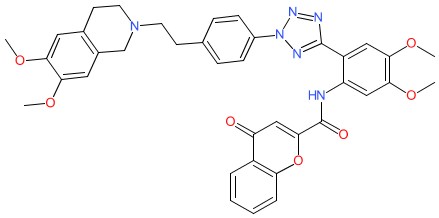|
Synonyms: HM-30181 | HM30181 | Oratecan (encequidar methanesulfonate + irinotecan) | Oraxol (encequidar methanesulfonate + paclitaxel)
Compound class:
Synthetic organic
Comment: Encequidar (HM30181) is an inhibitor of ATP-binding cassette (ABC) transporter P-glycoprotein (P-gp; ABCB1) [1], an intestinal efflux pump that eliminates endogenous and xenobiotic substrates (including a number of chemotherapy drugs) from the body. Overexpression of P-gp by some cancers mediates resistance to chemotherapeutics. Blocking P-gp efflux is proposed as a mechanism to improve the oral bioavailability of poorly soluble chemotherapy drugs such as irinotecan and paclitaxel. Encequidar is minimally absorbed which means that it acts principally at its preferred site of action in the intestine, and has negligible systemic exposure.
Ligand Activity Visualisation ChartsThese are box plot that provide a unique visualisation, summarising all the activity data for a ligand taken from ChEMBL and GtoPdb across multiple targets and species. Click on a plot to see the median, interquartile range, low and high data points. A value of zero indicates that no data are available. A separate chart is created for each target, and where possible the algorithm tries to merge ChEMBL and GtoPdb targets by matching them on name and UniProt accession, for each available species. However, please note that inconsistency in naming of targets may lead to data for the same target being reported across multiple charts. ✖ |
|
|||||||||||||||||||||||||||||||||||
| Selectivity at transporters | ||||||||||||||||||||||||||||||||||
| Key to terms and symbols | Click column headers to sort | |||||||||||||||||||||||||||||||||
|
||||||||||||||||||||||||||||||||||







